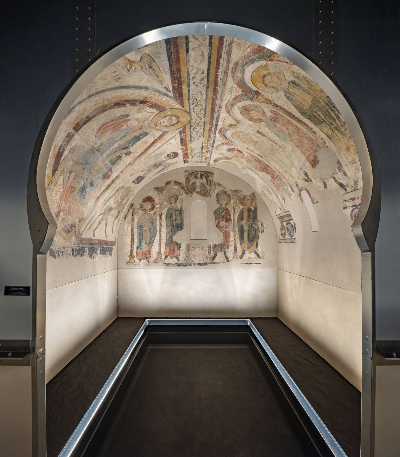
©
Романські церкви Андорри стали осередками створення виняткової мистецької спадщини, до якої належать настінні розписи з церков Санта-Колома та Сант-Естеве в Андорра-ла-Велья. Романське мистецтво (кінець X — початок XIII століття) об’єднувало християнську Європу спільною візуальною мовою, водночас демонструючи значне стилістичне розмаїття. Воно поєднувало античну спадщину Риму та традиції Каролінзької культури з новими духовними і художніми пошуками.
У першій половині XX століття, на тлі зростаючого інтересу до середньовічного мистецтва, посиленого культурним відродженням Renaixença, настінні розписи з церков Піренеїв — як каталонських, так і андоррських — почали масово скуповувати антиквари та колекціонери. Фрески демонтували зі стін за допомогою італійської техніки strappo, яка передбачає відокремлення лише верхнього шару живопису. У 1933 році антиквар Жузеп Бардолет придбав фрески церкви Санта-Колома та поділив ансамбль на частини:
• Фрагменти арки зі святими Григорієм і Сильвестром спочатку зберігалися в галереї Brummer у Нью-Йорку, згодом були розділені; один нині перебуває в музеї Mead (США), інший — втратився після перебування у Франції.
• Частини апсиди з Христом і апостолами були придбані бельгійським бароном Ван Касселем. Через переслідування євреїв він емігрував до США, але його колекцію конфіскували нацисти. Фрески пережили війну в соляних шахтах в Австрії, а згодом опинилися в музеях Мюнхена та Берліна. У 2007 році, завдяки зусиллям уряду Андорри та міжнародним угодам (Вашингтонська конференція 1998 року), фрески було повернуто спадкоємицям барона, які продали їх державі Андорра.
Подібна доля спіткала й фрески церкви Сант-Естеве, які у 1920-х роках були демонтовані й продані:
• Частина з апсидіолі зберігається у Національному музеї мистецтв Каталонії (MNAC) у Барселоні.
• Фрагмент "Таємної вечері" — в музеї Прадо в Мадриді.
• Інші елементи тривалий час перебували у власності родини Бош, проте у 2024 році були повернуті до Андорри.
Сьогодні фрески з Санта-Коломи та Сант-Естеве експонуються у трьох державних музеях Андорри. Їхнє повернення стало результатом багаторічної реституції та цілеспрямованих зусиль із збереження національної культурної спадщини.
Medieval Art: The Romanesque Churches of Andorra
The Romanesque churches of Andorra served as centers for the creation of an exceptional artistic legacy, most notably the wall paintings from the churches of Santa Coloma and Sant Esteve in Andorra la Vella. These churches were small, simple structures built from local stone. Their architectural features were marked by modesty, Lombard arches, and distinctive bell towers. Although they may seem austere today, in the Middle Ages they were vividly painted inside and out. Romanesque art (late 10th – early 13th century) united Christian Europe through a shared visual language, while also displaying considerable stylistic diversity. It combined the heritage of Rome and Carolingian culture with new spiritual and artistic explorations.
In the first half of the 20th century, amid growing interest in medieval art—fueled by the cultural revival known as Renaixença—the wall paintings of churches in the Catalan and Andorran Pyrenees began to be actively acquired by collectors and antiquarians. The frescoes were removed from walls using the Italian strappo technique, which involved separating only the upper painted layer. In 1933, the antiquarian Josep Bardollet purchased the frescoes from Santa Coloma and divided the ensemble into parts:
• Fragments of the arch depicting Saints Gregory and Sylvester ended up in the Brummer Gallery in New York, and were later separated. One piece is now in the Mead Art Museum (USA), while the other went missing after a period in France.
• Fragments of the apse showing Christ and the apostles were acquired by Belgian Baron Van Cassel. Forced to emigrate to the United States due to the persecution of Jews, his collection was later confiscated by the Nazis. The frescoes survived the war stored in Austrian salt mines, eventually reappearing in museums in Munich and Berlin.
In 2007, thanks to efforts by the Andorran government and international agreements (notably the 1998 Washington Conference), the frescoes were returned to the baron’s heirs, who subsequently sold them to the state of Andorra. A similar fate befell the wall paintings of Sant Esteve, which were also removed and sold in the 1920s:
• A portion of the apse now resides in the Museu Nacional d'Art de Catalunya (MNAC) in Barcelona.
• A fragment of the Last Supper is housed at the Prado Museum in Madrid.
• Other pieces remained in the possession of the Bosch family until 2024, when they were repatriated to Andorra.
Today, the frescoes from Santa Coloma and Sant Esteve are on display in three public museums across Andorra. Their return represents the culmination of a long process of restitution and a determined effort to preserve the country’s national cultural heritage.
1459